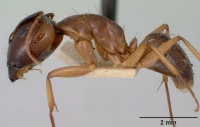Camponotus boivini
| Camponotus boivini | |
|---|---|

| |
| Scientific classification | |
| Kingdom: | Animalia |
| Phylum: | Arthropoda |
| Class: | Insecta |
| Order: | Hymenoptera |
| Family: | Formicidae |
| Subfamily: | Formicinae |
| Tribe: | Camponotini |
| Genus: | Camponotus |
| Subgenus: | Myrmosaga |
| Species: | C. boivini |
| Binomial name | |
| Camponotus boivini Forel, 1891 | |
| Synonyms | |
| |
The distribution of C. boivini is generally limited to western and the high plateau of Madagascar. This species occurs mostly in dry forest habitats in the north through spiny forest areas in the south. Along its north-south range it can be found in gallery forests, disjunct montane rainforest, Uapaca woodlands, and savannah grasslands. When nesting in rotten logs, rotting tree stumps, under stones, in dead branches, twigs on the ground, and in the soil, C. boivini typically forages in leaf litter and seldom on the forest floor and low vegetation.
Identification
Rakotonirina and Fisher (2022) - Lateral cephalic margins approximately parallel in full-face view; two apical teeth of mandible normally spaced; antennal scape covered with suberect hairs inclined at ca. 45°; in lateral view, posterior 1/2 of mesonotum to posterodorsal corner of propodeum somewhat convex, propodeal dorsum ca. 2 × as long as the height of declivity surface.
Camponotus boivini may be confused with Camponotus cemeryi but the latter is characterized by a short and high mesosoma which shows a strongly convex dorsal outline. Camponotus boivini can be confounded with Camponotus mixtellus but workers of the latter species have an antennal scape covered with suberect hairs inclined at ca. 30°, are generally larger (CS: 1.56±0.13; 1.16–1.83; ML: 2.76±0.16; 3.10–3.45), and are mostly found in the rainforest of the region.
Keys including this Species
Distribution
Distribution based on Regional Taxon Lists
Malagasy Region: Madagascar (type locality), Seychelles.
Distribution based on AntMaps
Distribution based on AntWeb specimens
Check data from AntWeb
Countries Occupied
| Number of countries occupied by this species based on AntWiki Regional Taxon Lists. In general, fewer countries occupied indicates a narrower range, while more countries indicates a more widespread species. |

|
Estimated Abundance
| Relative abundance based on number of AntMaps records per species (this species within the purple bar). Fewer records (to the left) indicates a less abundant/encountered species while more records (to the right) indicates more abundant/encountered species. |

|
Biology
Castes
Worker
Images from AntWeb
 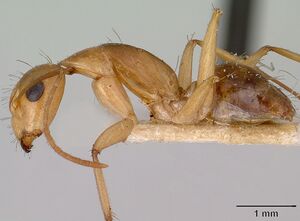 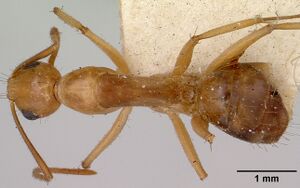 
| |
| Lectotype of Camponotus boivini. Worker. Specimen code casent0101343. Photographer April Nobile, uploaded by California Academy of Sciences. | Owned by MHNG, Geneva, Switzerland. |
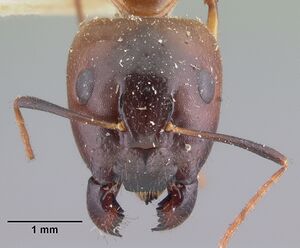 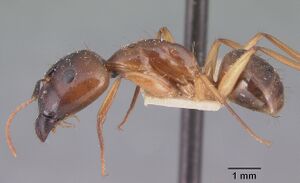  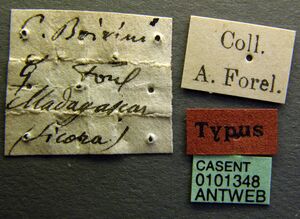
| |
| Paralectotype of Camponotus boivini. Worker (major/soldier). Specimen code casent0101348. Photographer April Nobile, uploaded by California Academy of Sciences. | Owned by MHNG, Geneva, Switzerland. |
    
| |
| Paralectotype of Camponotus boivini. Worker. Specimen code casent0101349. Photographer April Nobile, uploaded by California Academy of Sciences. | Owned by MHNG, Geneva, Switzerland. |
 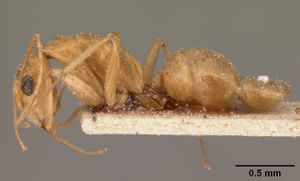 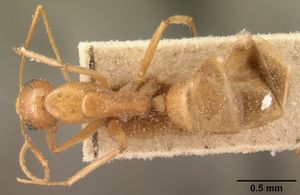 
| |
| Lectotype of Camponotus maculatus fairmairei. Worker. Specimen code casent0101102. Photographer April Nobile, uploaded by California Academy of Sciences. | Owned by NHMB, Basel, Switzerland. |
Male
Images from AntWeb
    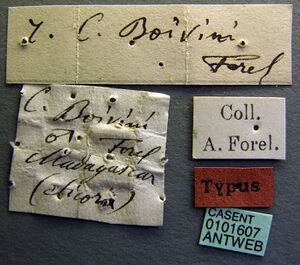
| |
| Paralectotype of Camponotus boivini. Male (alate). Specimen code casent0101607. Photographer Nick Olgeirson, uploaded by California Academy of Sciences. | Owned by MHNG, Geneva, Switzerland. |
Nomenclature
The following information is derived from Barry Bolton's Online Catalogue of the Ants of the World.
- boivini. Camponotus maculatus r. boivini Forel, 1891b: 34 (s.w.q.) MADAGASCAR.
- Type-material: lectotype minor worker (by designation of Rakotonirina & Fisher, 2022: 58), 2 paralectotype major workers, 1 paralectotype minor worker, 1 paralectotype queen, 1 paralectotype male.
- [Note: the male is not mentioned in the original description.]
- Type-locality: lectotype Madagascar: “probably Imerina” (F. Sikora); paralectotypes: workers with same data, queen Madagascar: (no further data) (Boivin).
- Type-depositories. MHNG (lectotype), MHNG, MNHN (paralectotypes).
- Forel, 1891b: 213 (m.).
- Combination in C. (Tanaemyrmex): Emery, 1925b: 86;
- combination in C. (Myrmosaga): Rakotonirina & Fisher, 2022: 58.
- Status as species: Dalla Torre, 1893: 223.
- Subspecies of maculatus: Forel, 1891b: 213; Emery, in Dalla Torre, 1893: 241 (footnote); Emery, 1895f: 337; Emery, 1896d: 370 (in list); Forel, 1907d: 92; Wheeler, W.M. 1922a: 1040.
- Subspecies of hova: Emery, 1920c: 6; Emery, 1925b: 86; Bolton, 1995b: 89; Dorow, 1996a: 86.
- Status as species: Rakotonirina & Fisher, 2022: 58 (redescription).
- Senior synonym of fairmairei: Rakotonirina & Fisher, 2022: 58.
- Distribution: Madagascar.
- fairmairei. Camponotus maculatus st. fairmairei Santschi, 1911e: 130, fig. 3b, e (s.w.) MADAGASCAR.
- Type-material: lectotype minor worker (by designation of Rakotonirina & Fisher, 2022: 58).
- [Note: original description indicates 3 major and minor worker syntypes.]
- Type-locality: lectotype Madagascar: (no further data), 1900 (L. Fairmaire).
- Type-depository: NHMB (lectotype) (perhaps also MNHN).
- Combination in C. (Tanaemyrmex): Emery, 1925b: 86.
- Subspecies of maculatus: Wheeler, W.M. 1922a: 1040.
- Subspecies of hova: Emery, 1920c: 6; Emery, 1925b: 86; Bolton, 1995b: 98.
- Junior synonym of boivini: Rakotonirina & Fisher, 2022: 58.
Unless otherwise noted the text for the remainder of this section is reported from the publication that includes the original description.
Description
Worker
Rakotonirina and Fisher (2022):
Morphological measurements: see Appendix 1 and Ratios of morphometric data for majors and minors
Minor In full-face view, lateral cephalic borders anterior to level of eye parallel to each other, converging progressively towards posterior margin behind eye level; eye protruding and large (EL/CS: 0.32±0.02; 0.29–0.36), breaking lateral cephalic margins; head sides behind eye level 1/4 length of head (PoOc/CL: 0.27±0.01; 0.24–0.30); frontal carinae widely diverging posteriorly (FR/CS: 0.32±0.01; 0.30–0.35); clypeus with anterolateral angle, its anteromedian margin with blunt angle or convex; mandible with two apical teeth distant from each other; antennal scape relatively long (SL/CS: 1.37±0.10; 1.22–1.56). Promesonotum weakly convex and mesopropodeum feebly convex, mesonotum with posterior portion flat immediately anterior to metanotal groove, metanotum weakly visible, propodeal dorsum anteriorly convex and posteriorly flat, dorsal margin of propodeum and declivity joining at a blunt angle, height of propodeal declivity 1/2 length of propodeal dorsum. Petiolar node flattened, short, and high, without noticeable dorsal margin; tibia of hind leg rounded axially, without twist in the basal portion.
First and second gastral tergites without a pair of white spots; lateral margin of head anterior to eyes level with erect hairs, which are absent behind eyes; posterior margin of head with a pair of erect hairs; antennal scape covered with erect hairs inclined at 45°; posterodorsal angle of propodeum with a pair of erect hairs.
Major Differing from minor worker in having larger head (CS: 2.29±0.28; 1.96–3.12; CWb/CL: 0.91±0.04; 0.86–0.99), short antennal scape barely surpassing posterior cephalic margin; robust mesosoma with distinct metanotum, and petiolar node as high as long. Other characters as in Minor
Type Material
Camponotus maculatus boivini
- Syntype workers, queen and male, Madagascar (Sikora) (MHNG); 1 syntype minor worker designated as lectotype, by present designation, AntWeb CASENT0101343 (MHNG) [Rakotonirina & Fisher, 2022].
- Paralectotypes with same data as lectotype but: 1 minor worker CASENT0101349, 2 major workers CASENT0101342, CASENT0101348 and 1 male CASENT0101607 (MHNG) [Rakotonirina & Fisher, 2022].
One major worker and one male specimen that are labeled respectively with CASENT0104638 and CASENT0104637 (ZMHB), were collected from Mahajanga, and are labeled with an unpublished name “Camponotus maculatus subsp. hova var. laticollus” by Forel. Rakotonirina & Fisher (2022) identify these two specimens as Camponotus boivini.
Camponotus maculatus fairmairei
- Syntype workers Madagascar, colony living with larvae of Fulgorids (Fairmaire, 1900) (NHMB); 1 syntype minor worker designated as lectotype, by present designation, AntWeb CASENT0101102 (NHMB) [Rakotonirina & Fisher, 2022].
Taxonomic Notes
Santschi (1911a) originally described Camponotus maculatus st. fairmairei without any comparison of the specimens to those of other species, though his description corresponds to the type specimens of C. boivini. The observation of the samples and the distributional data obtained from the recent ant survey in Madagascar combined with this information are sufficiently enough to reasonably synonymize Camponotus maculatus st. fairmairei with C. boivini. (Rakotonirina & Fisher, 2022)
References
- Bolton, B. 1995b. A new general catalogue of the ants of the world. Cambridge, Mass.: Harvard University Press, 504 pp. (page 89, catalogue)
- Dalla Torre, K. W. von. 1893. Catalogus Hymenopterorum hucusque descriptorum systematicus et synonymicus. Vol. 7. Formicidae (Heterogyna). Leipzig: W. Engelmann, 289 pp. (page 223, raised to species)
- Emery, C. 1895g. Mission scientifique de M. Ch. Alluaud dans le territoire de Diego-Suarez (Madagascar-nord) (Avril-août 1893). Formicides. Ann. Soc. Entomol. Belg. 39: 336-345 (page 337, subspecies of maculatus)
- Emery, C. 1920d. Studi sui Camponotus. Bull. Soc. Entomol. Ital. 52: 3-48 (page 6, subspecies of hova)
- Emery, C. 1925d. Hymenoptera. Fam. Formicidae. Subfam. Formicinae. Genera Insectorum 183: 1-302 (page 86, combination in C. (Tanaemyrmex))
- Emery, C. 1925d. Hymenoptera. Fam. Formicidae. Subfam. Formicinae. Genera Insectorum 183: 1-302 (page 86, subspecies of hova)
- Forel, A. 1891c. Les Formicides. [part]. In: Grandidier, A. Histoire physique, naturelle, et politique de Madagascar. Volume XX. Histoire naturelle des Hyménoptères. Deuxième partie (28e fascicule). Paris: Hachette et Cie, v + 237 pp. (page 34, worker, queen described)
- Forel, A. 1891c. Les Formicides. [part]. In: Grandidier, A. Histoire physique, naturelle, et politique de Madagascar. Volume XX. Histoire naturelle des Hyménoptères. Deuxième partie (28e fascicule). Paris: Hachette et Cie, v + 237 pp. (page 213, male described)
- Rakotonirina, J.C., Fisher, B.L. 2022. Revision of the Malagasy Camponotus subgenus Myrmosaga (Hymenoptera, Formicidae) using qualitative and quantitative morphology. ZooKeys 1098: 1–180 (doi:10.3897/zookeys.1098.73223).
- Wheeler, W. M. 1922k. Ants of the American Museum Congo expedition. A contribution to the myrmecology of Africa. IX. A synonymic list of the ants of the Malagasy region. Bull. Am. Mus. Nat. Hist. 4 45: 1005-1055 (page 1040, subspecies of maculatus)
